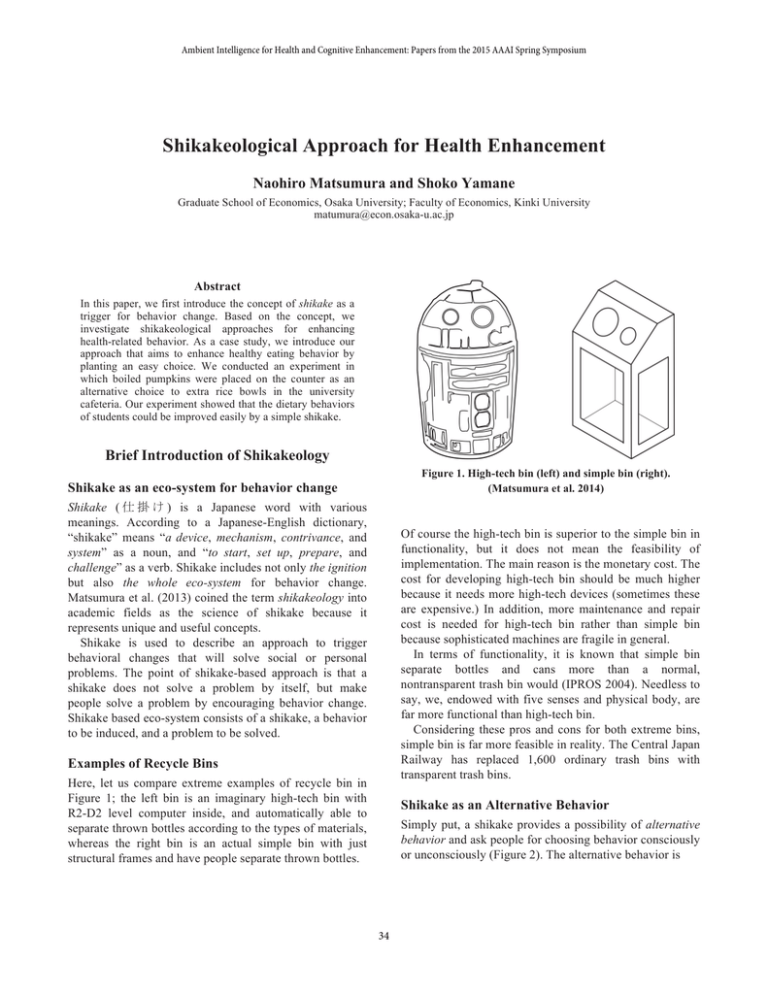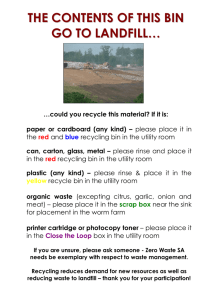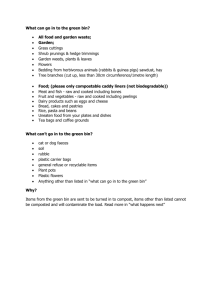Document 13910597
advertisement

Ambient Intelligence for Health and Cognitive Enhancement: Papers from the 2015 AAAI Spring Symposium Shikakeological Approach for Health Enhancement Naohiro Matsumura and Shoko Yamane Graduate School of Economics, Osaka University; Faculty of Economics, Kinki University matumura@econ.osaka-u.ac.jp Abstract In this paper, we first introduce the concept of shikake as a trigger for behavior change. Based on the concept, we investigate shikakeological approaches for enhancing health-related behavior. As a case study, we introduce our approach that aims to enhance healthy eating behavior by planting an easy choice. We conducted an experiment in which boiled pumpkins were placed on the counter as an alternative choice to extra rice bowls in the university cafeteria. Our experiment showed that the dietary behaviors of students could be improved easily by a simple shikake. Brief Introduction of Shikakeology Figure 1. High-tech bin (left) and simple bin (right). (Matsumura et al. 2014) Shikake as an eco-system for behavior change Shikake ( ) is a Japanese word with various meanings. According to a Japanese-English dictionary, “shikake” means “a device, mechanism, contrivance, and system” as a noun, and “to start, set up, prepare, and challenge” as a verb. Shikake includes not only the ignition but also the whole eco-system for behavior change. Matsumura et al. (2013) coined the term shikakeology into academic fields as the science of shikake because it represents unique and useful concepts. Shikake is used to describe an approach to trigger behavioral changes that will solve social or personal problems. The point of shikake-based approach is that a shikake does not solve a problem by itself, but make people solve a problem by encouraging behavior change. Shikake based eco-system consists of a shikake, a behavior to be induced, and a problem to be solved. Of course the high-tech bin is superior to the simple bin in functionality, but it does not mean the feasibility of implementation. The main reason is the monetary cost. The cost for developing high-tech bin should be much higher because it needs more high-tech devices (sometimes these are expensive.) In addition, more maintenance and repair cost is needed for high-tech bin rather than simple bin because sophisticated machines are fragile in general. In terms of functionality, it is known that simple bin separate bottles and cans more than a normal, nontransparent trash bin would (IPROS 2004). Needless to say, we, endowed with five senses and physical body, are far more functional than high-tech bin. Considering these pros and cons for both extreme bins, simple bin is far more feasible in reality. The Central Japan Railway has replaced 1,600 ordinary trash bins with transparent trash bins. Examples of Recycle Bins Here, let us compare extreme examples of recycle bin in Figure 1; the left bin is an imaginary high-tech bin with R2-D2 level computer inside, and automatically able to separate thrown bottles according to the types of materials, whereas the right bin is an actual simple bin with just structural frames and have people separate thrown bottles. Shikake as an Alternative Behavior Simply put, a shikake provides a possibility of alternative behavior and ask people for choosing behavior consciously or unconsciously (Figure 2). The alternative behavior is 34 Figure 2. A shikake as an alternative behavior. Figure 4. Changes of effort and utility with time. Figure 3. Strength and weakness of a shikake. Figure 5. Duration of a shikake. just an option and no need to follow the choice; nothing happen when keeping an ordinary behavior. However, the alternative behavior is designed to induce a specific behavior, which will contribute to solve a problem in the end (Matsumura et al. 2013). The point of this approach is that a shikake does not force people to change behavior, but just propose an alternative behavior. People can choose their own behavior, and as a result nobody would consider to be taken in a trap. This win-win situation for solving a problem is the essence of shikakeological approach. Based on these two factors, we can consider the strength of a shikake. That is, a shikake with high utility and low effort is said to be a strong shikake because more people is expected to choose alternative behavior. On the contrary, a shikake with low utility and high effort is considered as a weak shikake because it would not attract people. These relations are depicted in Figure 3. Duration of Shikakes Because of the difficulty in keeping up interest in anything, the utility for a shikake decreases as time goes by, whereas the effort for changing behavior would be constant. Considering these characteristics with time, we can estimate the duration of shikakes. In Figure 4, the left figure shows the relationships between effort and time, and the right figure shows the relationships between utility and time. The decay curve and the level of efforts are different from each shikake. Some shikakes decay rapidly, but slowly for the others. The levels of effort are high for some shikakes, but low for the others. The relationships are depicted in Figure 4. Strength of Shikake The strength and weakness of shikake effects are characterized by the utility that is given from and the effort that we have to invest in. Here, a utility is a psychological benefit, such as surprise, fun, risk avoidance, etc. An effort is a physical or mental endeavor, such as exercise, complex decision-making, etc. When a shikake-driven behavior provides high utility for users, they would choose the behavior willingly. However, a shikake-driven behavior needs much effort, people would hesitate to choose the behavior. 35 Even if a shikake can occur behavior change at first, the behavior change would disappear sooner or later. The moment will happen when the utility becomes low compared to the level of effort. If the utility is high enough or the effort is less enough, the duration of a shikake would be long, as shown in Figure 5. We conducted the experiment above and found that extra rice and the boiled pumpkin were alternatives; boiled pumpkin could reduced the consumption of extra rice (Oka et al. 2013). Acknowledgement This work was supported by JSPS KAKENHI Grant Number 24603011. Shikakeological Approach When confronted with a problem (ex. litters in my room), a shikake could be an approach worth challenging. Followings are the basic process for designing a shikake. The first step is to define a behavior that solves the problem. For example, throwing garbage into a bin is one of the behaviors to solve the problem. If the behavior needs much effort or provides less utility, the behavior might not be an adequate behavior. In the case of throwing garbage, the behavior seems to be OK because it is easy to perform and possibly be able to add some utility to the action. The next step is to add shikake trigger elements (Matsumura et al. 2014) to an object by making it fun, being interactive with users, or being aware of clues. Creating an original shikake idea is a hard task, but making a shikake based on the previously found shikake examples is helpful to not only come up with shikakes but also predict the reaction of people. References IPROS 2004 Transparent eco-duster catalogue. IPROS CORPORATION. Matsumura, N., Fruchter, R., and Leifer, L. 2014 Shikakeology: Designing Triggers for Behavior Change, AI & Society. (Online First, 07 Oct 2014) Shunichiro Oka, Shoko Yamane, and Naohiro Matsumura 2013 Boiled Pumpkin as a Nudge: Evidence from a University Cafeteria, AAAI 2013 Spring Symposium on Shikakeology, pp. 74-78. Case Study of University Cafeteria Through the study on the purchasing records in the school cafeteria (for 1321 male and 192 female, between December 1 and December 28 in 2011), we found that the students tend to spend the full daily allowance on their meal cards (Oka et al. 2013). Based on this tendency, we conducted an experiment in which boiled pumpkin was placed on the counter as a shikake with the rice bowl dishes in the school cafeteria. We intended a boiled pumpkin as an alternative to an extra rice to improve the students' diet. The point here is that the price of the boiled pumpkin and extra rice is the same, 50 JPY (approximately 0.43 USD as of January 17, 2015). In this case, choosing the boiled pumpkin instead of extra rice does not increase the effort, whereas the utility might be complex. Someone might benefit from adopting vitamins, but the others might worry about the lack of full stomach. Those who consider cost performance in terms of calorie intake might get utility from choosing extra rice rather than a pumpkin. In any cases, showing boiled pumpkin as an alternative choice would at least get attention of health-conscious people and be expected to increase their health enhancement. For these reasons, the boiled pumpkin is considered as a shikakeological approach for health enhancement. 36




